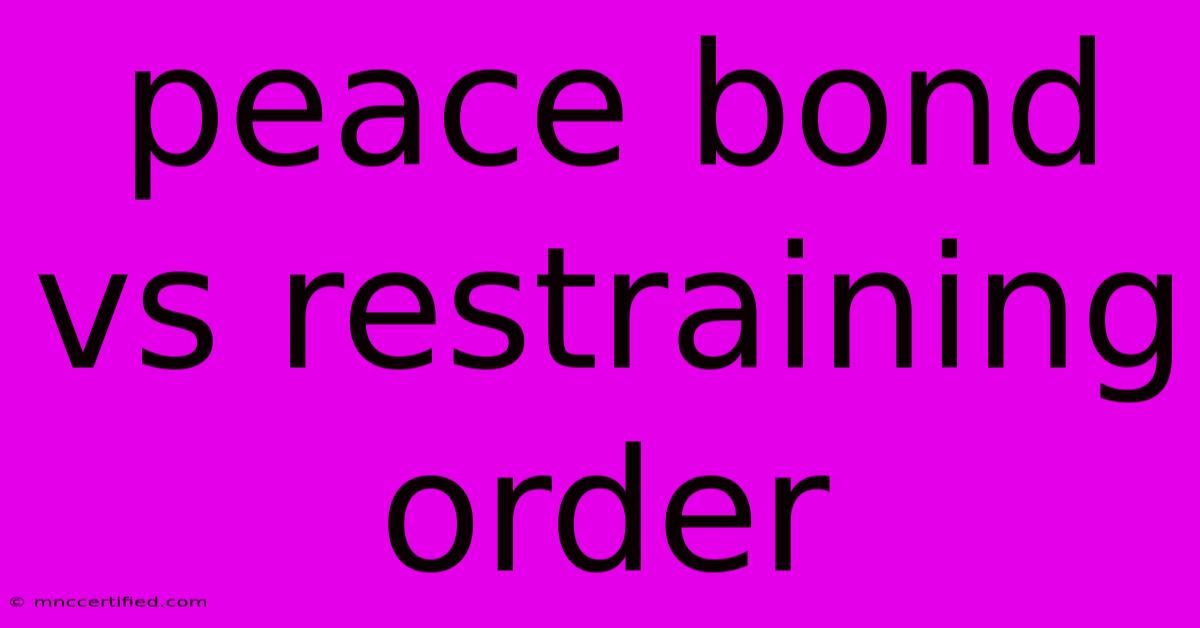Peace Bond Vs Restraining Order

Table of Contents
Peace Bond vs. Restraining Order: Understanding the Key Differences
Choosing between a peace bond and a restraining order can be confusing, especially when dealing with harassment, threats, or violence. Both aim to protect individuals from harm, but they differ significantly in their purpose, application, and consequences. This article will clarify the key distinctions between peace bonds and restraining orders, helping you understand which might be appropriate in your situation.
What is a Peace Bond?
A peace bond, also known as a peace undertaking or recognizance, is a legal agreement where an individual promises to maintain the peace and be of good behavior for a specified period. It's a preventative measure, primarily used when there's a reasonable belief that someone might commit a future offense, even if no crime has yet occurred. The court doesn't find the individual guilty of anything; instead, it aims to prevent potential future harm.
Key characteristics of a peace bond:
- Proactive: Prevents potential future harm.
- No finding of guilt: The individual isn't declared guilty of any crime.
- Conditions: The bond often includes specific conditions, such as avoiding contact with the protected person, refraining from certain activities (e.g., possessing weapons), or attending counseling.
- Breach: Violating the conditions can lead to serious consequences, including arrest and potential criminal charges.
- Application: Usually applied in cases of threats, harassment, or escalating conflicts before violence has occurred.
What is a Restraining Order?
A restraining order, also known as a protection order or injunction, is a court order that legally prohibits someone from contacting, approaching, or otherwise interacting with a specific person. It's a reactive measure, typically issued after an incident of violence, abuse, or harassment has already happened. The court finds that the protected individual needs legal protection from the respondent.
Key characteristics of a restraining order:
- Reactive: Issued after an incident of harm or credible threat.
- Finding of harm: The court acknowledges harm or a credible threat of harm has occurred.
- Specific prohibitions: Clearly defines prohibited actions, such as contacting the protected person, going near their home or workplace, and possessing weapons.
- Breach: Violating a restraining order is a criminal offense, leading to immediate arrest.
- Application: Used in cases of domestic violence, stalking, harassment, and other situations where there's a proven history of abuse or credible threat.
Peace Bond vs. Restraining Order: A Comparison Table
| Feature | Peace Bond | Restraining Order |
|---|---|---|
| Nature | Preventative | Reactive |
| Finding of Guilt | No | Not directly, but acknowledges harm/threat |
| Purpose | Prevent future harm | Protect from further harm |
| Application | Potential future harm, threats, escalating conflict | Proven harm, abuse, stalking, harassment |
| Enforcement | Breach is a criminal offense | Breach is a criminal offense |
| Conditions | May include conditions of behavior | Clearly defines prohibited actions |
Which One Do I Need?
The choice between a peace bond and a restraining order depends on your specific circumstances. If you're concerned about potential future harm but there's no history of violence or abuse, a peace bond might be suitable. However, if you've already experienced violence, abuse, or harassment, a restraining order provides stronger legal protection and a clear legal record of the harm inflicted.
It's crucial to seek legal advice. An attorney can assess your situation, advise you on the best course of action, and represent you in court if necessary. They can help you navigate the legal complexities of both peace bonds and restraining orders and ensure your safety and legal rights are protected.
Off-Page SEO Considerations
To boost the ranking of this article, consider the following off-page SEO strategies:
- Link Building: Reach out to relevant websites (legal blogs, domestic violence resources) and request links to your article.
- Social Media Promotion: Share the article on social media platforms, targeting relevant groups and individuals.
- Guest Blogging: Write guest posts on other websites in the legal or self-help niche, including a link back to your article.
- Forum Participation: Participate in online forums related to legal issues and subtly mention the article when relevant.
By implementing both on-page and off-page SEO techniques, you can significantly increase the visibility and ranking of this informative article on peace bonds versus restraining orders. Remember, always consult with legal professionals for advice on specific legal matters.

Thank you for visiting our website wich cover about Peace Bond Vs Restraining Order. We hope the information provided has been useful to you. Feel free to contact us if you have any questions or need further assistance. See you next time and dont miss to bookmark.
Featured Posts
-
Rooneys Biggest Controversies Coleen Speaks
Nov 22, 2024
-
Legal Forex Trading App In India
Nov 22, 2024
-
Week 13 Bengals Stars Win Guarantee
Nov 22, 2024
-
Steelers Browns Game Who Won
Nov 22, 2024
-
Amber Warning Storm Bert Impacts Scotland
Nov 22, 2024